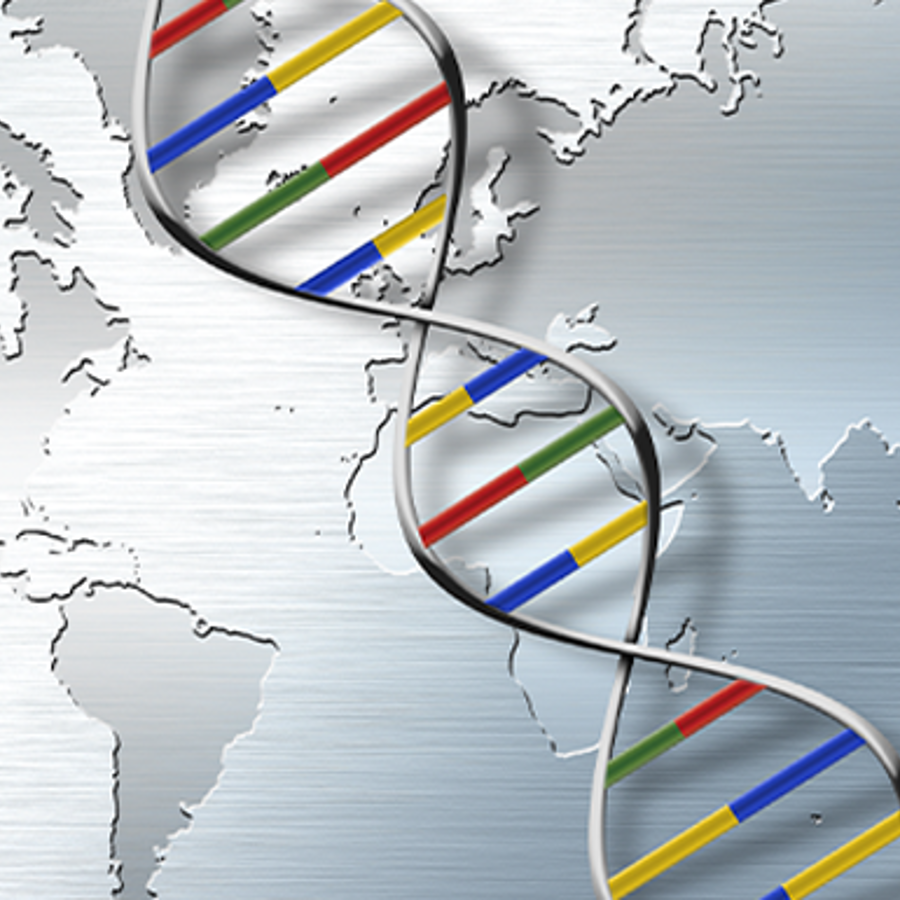
A white supremacist said his 14% African ancestry is just 'statistical noise'. Is that true?
December 5, 2013

- Related Topics:
- Editor's choice,
- Ancestry,
- Ancestry tests
A curious adult from California asks:
"I recently saw a YouTube video about a white supremacist who took a genetic test and found out he was 14% sub-Saharan African. What does that percentage mean? When I listened to the video, the man said it was just statistical noise. Could it have been?"
For those of you who haven’t seen the video, here it is.
Given that the number is so large, this result is very unlikely to be statistical noise. In other words, 14% means that there is almost certainly some sub Saharan African DNA in his DNA.
Craig Cobb probably had a pretty recent relative that had a whole lot of sub Saharan African in his or her DNA. Something along the lines of a great grandparent that was 100% sub Saharan African. Or many ancestors, each of whom had smaller amounts of African ancestry.
But we shouldn’t get too hung up on the 14%. It could be that he actually has only 5% or has 20% instead. Such is the current state of these tests…
The results also depend on the testing company used. Different ancestry tests may give somewhat different results. But again, 14% is big enough that most any test would probably detect it.
So the bottom line is that he has ancestry from sub-Saharan Africa. It is up to him what he wants to do with those results.
By the way, he isn’t alone in getting these kinds of results. It is actually pretty common for people to find out that their family tree is a whole lot more interesting than they thought especially in a melting pot like the U.S. Shows that how you look does not necessarily reflect your family history.
For the rest of the answer I want to quickly go over why Mr. Cobb’s 14% means he could have a pretty recent relative who was from sub Saharan Africa. Then I’ll give an example that someone could correctly claim as statistical noise.
Halfish Each Generation
You got half your DNA from your mom and half from your dad. The same is true for them—they each got half their DNA from their mom and half from their dad. This continues in each generation.
To show where the 14% comes from, let’s start with Mr. Cobb’s great grandparent. We will say his DNA is 100% sub Saharan African. We will represent this as an orange circle like this:
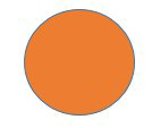
Now let’s say that everyone else from here on out has DNA that is 100% European. We’ll represent that with blue circles. Here is what their child would look like:
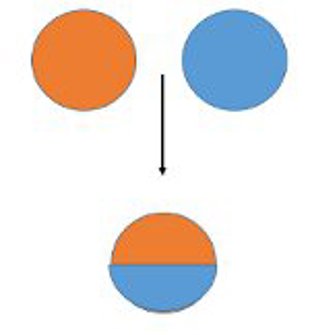
The parents are shown on the top and the child is at the end of the arrow. As you can see, the child is half European (blue) and half sub Saharan African (orange). Let’s keep going:
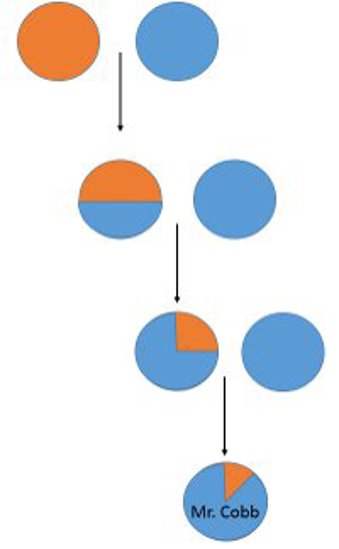
As you can see, each generation has half as much sub Saharan African until you get to the ~12.5% that Craig Cobb has.
Keep in mind this is just one way that this might have happened. He might also have had two great grandparents that each had 50% sub Saharan African or someone else further down the tree might have had some too. One thing we can say is that his DNA is around 1/7th sub Saharan African.
Before leaving this topic, one important point to make is that while we always get half our DNA from our mom and half from our dad, this does not mean we always get 25% from each grandparent or 12.5% from each great grandparent. Because of how DNA is passed down, you might get more from one grandparent or another and so on up the family tree. Click here to learn more about this.
What this means is that Mr. Cobb could have had a more recent relative who was sub Saharan African or a more distant one. Here is what the more recent one might look like:
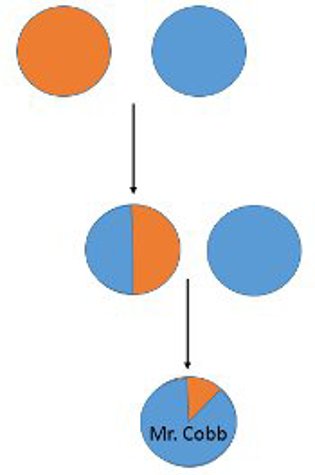
By chance, one of his parents just happened to pass more European as opposed to sub Saharan African DNA. The odds of this happening are pretty slim but it is technically possible. A more distant relative is a bit more likely but still not as likely as these others.
As a final point, remember I said that the 14% should be taken with a grain of salt. We know he has some sub Saharan African DNA but the real value could be more or less. If it is less than he has a more distant sub Saharan African relative and if it is more, he has a more recent one. As you can see, this is not an exact science just yet!
But whatever the true percentage, he does indeed have some sub Saharan African DNA in his.
Statistically Noisy?
Mr. Cobb protests in the video that his result comes from statistical noise. As I said before, this is extremely unlikely given the fact that the number is 14%.
But if it were say 0.1%, then he might have an argument. In fact, this is exactly what happened to me.
I have done two separate DNA ancestry tests and have received subtly different results. Here are my results from 23andMe:
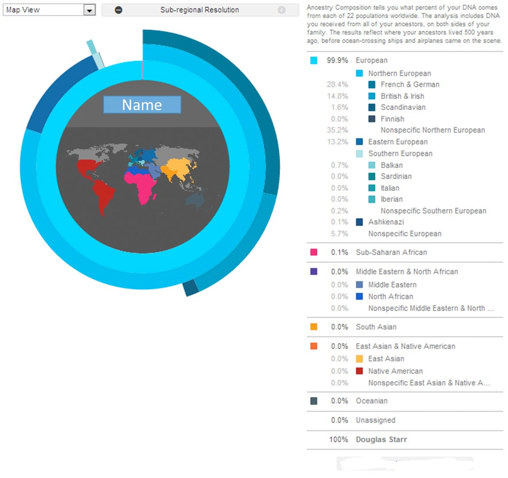
What you can see is that there is around 0.1% sub-Saharan African DNA in my genome. I’m not showing it here, but another results page shows it is located on the very end of one of my chromosomes.
Given that my dad’s family is from the southern U.S., this didn’t surprise me that much. These kinds of results are actually pretty common.
Through the course of my researching other testing companies, I had a second test done by ancestry.com. Here are those results:
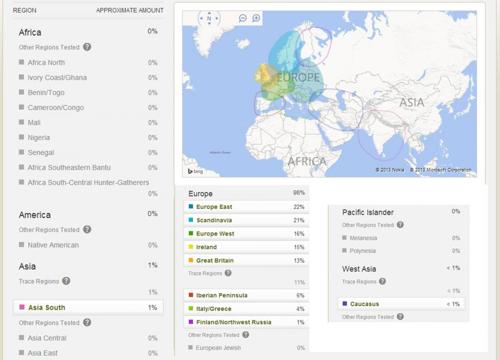
As you can see, the results are similar but not identical. For example, my sub Saharan African is lost in my ancestry.com results. We don’t know which test is “right” although at 0.1%, even the 23andMe result is telling me that my sub Saharan African relative was from a very long time ago.
You can probably also see that these tests are not perfect yet. They agree that my most recent relatives came from Europe but don’t completely mesh as to where they came from in Europe. As more and more people get tested, these tests should get more and more precise.

Author: Dr. D. Barry Starr
Barry served as The Tech Geneticist from 2002-2018. He founded Ask-a-Geneticist, answered thousands of questions submitted by people from all around the world, and oversaw and edited all articles published during his tenure. AAG is part of the Stanford at The Tech program, which brings Stanford scientists to The Tech to answer questions for this site, as well as to run science activities with visitors at The Tech Interactive in downtown San Jose.
 Skip Navigation
Skip Navigation
